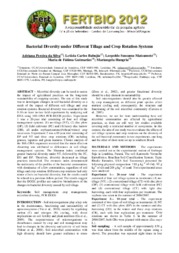Bacterial diversity under different tillage and crop rotation systems.
Bacterial diversity under different tillage and crop rotation systems.
Author(s): SILVA, A. P.; BABUJIA, L. C.; MATSUMOTO, L. S.; GUIMARÃES, M. de F.; HUNGRIA, M.
Summary: Microbial diversity can be used to assess the impact of agricultural practices on the long-term sustainability of cropping systems. The aim of this study was to investigate changes in soil bacterial diversity as a result of the impact of different soil tillage and crop rotation systems. Bacterial diversity was examined in the 0-10 cm layer in two field experiments by analyzing soil DNA using 16S rDNA PCR-DGGE profiles. Experiment 1 was a 26-year trial consisting of four soil tillage management systems: (1) no-tillage (NT), (2) disc plow (DP), (3) field cultivator (FC) and (4) heavy-disc harrow (DH), all under soybean(summer)/wheat(winter) crop succession. Experiment 2 was a 10-year trial consisting of DP and NT and three crop rotations (CR) including grasses, legumes and green manures. Cluster analysis of the 16S rDNA sequences revealed that the main effect on clustering was attributed to differences in soil tillage management systems. The Shannon index confirmed greater bacterial diversity under NT, followed by the FC, DH and DP. Therefore, diversity decreased as tillage practices intensified. The evenness index demonstrated the uniformity of the profiles of the bacterial communities with dominance of a few communities, regardless of soil tillage and crop rotation. Different crop rotations had only minor effects on bacterial diversity, but the results could be related to a previous fallow period. The results suggest that the DGGE profiles are sensitive bioindicators of the changes in bacterial diversity caused by soil tillage.
Publication year: 2012
Types of publication: Paper in annals and proceedings
Unit: Embrapa Soybean
Keywords: Crop rotation, Rotação de cultura, Sistema de cultivo
Observation
Some of Embrapa's publications are published as ePub files. To read them, use or download one of the following free software options to your computer or mobile device. Android: Google Play Books; IOS: iBooks; Windows and Linux: Calibre.
Access other publications
Access the Agricultural Research Database (BDPA) to consult Embrapa's full library collection and records.
Visit Embrapa Bookstore to purchase books and other publications sold by Embrapa.

